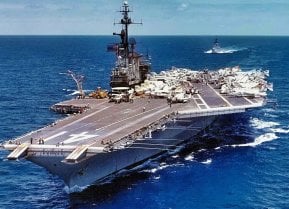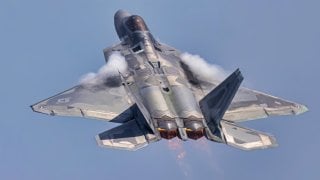Is America Ready for the F-22 Raptor's Retirement?
The F-22 Raptor’s reign may be coming to an end in the 2030s, but the United States has no intention of giving up its crown.
For some time now, the Air Force has been openly discussing plans to retire its most potent air superiority fighter, the F-22 Raptor, in favor of its next fighter in development. And while the exact timeline remains somewhat murky, the fact of the matter remains: The reign of the Raptor is coming to an end.
When the Lockheed Martin F-22 Raptor first rolled onto the flight line in 1997, it was an aircraft so unlike anything in service that it would soon be embraced as the basis from which a new generation of fighters would emerge what most of us know as the 5th generation. Now, a full quarter-century later, only three more tactical jets have found their way into service with sufficiently advanced capabilities to earn that coveted 5th-gen designation. And despite these jets being newer than (and often based in some part on) the F-22, the venerable Raptor is still widely considered to be the most potent air-to-air fighter on the planet.
Independent analysis of the F-22’s stealth and combat capabilities, especially as compared to Chinese and Russian fighters that are widely considered to be less stealthy, remains favorable. And with far older platforms like the F-15, F-16 and F/A-18 not only still in service, but still receiving upgrades, many have come to ask…
Why on earth would the U.S. want to retire the F-22 Raptor?
BLUFF – BOTTOM LINE UP FRONT
The F-22 Raptor is still widely considered to be the most capable air superiority fighter on the planet, but it’s slated for retirement in the 2030s. Here’s why:
-
The F-22 was canceled after just 186 airframes were delivered and large portions of its production line were then used for the F-35, making building new Raptors all but impossible.
- The F-22’s design and avionics are increasingly dated. The cost of modernizing it for the decades to come would be untenable (and still wouldn’t solve all of its problems).
- The F-22 will be replaced by a new fighter being developed in the Next Generation Air Dominance Program.
- The F-22 is being retired sooner than older jets because of its small numbers and high cost of operation.
THE RAPTOR HAS BEEN AN ENDANGERED SPECIES FROM THE START
The F-22 was born out of the Air Force’s Advanced Tactical Fighter program, an effort that really began all the way back in 1981, when the Air Force first developed and established its list of requirements for a next-generation air superiority fighter meant to replace the already-legendary F-15 Eagle. In 1981, the Cold War was still very much alive and well, and while the F-15 was designed as an answer to what America thought the MiG-25 was capable of, the Air Force believed that it would only be a matter of time before the Soviets fielded their own next-generation fighter meant to counter the F-15.
So, in order to maintain America’s competitive edge, there was no time to rest on the F-15’s laurels. By 1985, the Air Force was sending out requests for proposals, and by as early as 1991, the YF-22 was not only already flying, it had won the competition to move into production. Six years later, in 1997, the first production F-22 took flight, and eight years after that, it was in service.
But the same year Lockheed Martin won the contract to build the F-22, the Soviet Union collapsed. America had won the Cold War. By the time the F-22 went into service, the U.S. was no longer trying to deter a mighty nation-level opponent. Instead, it was waging war in multiple theaters against terrorist groups with no appreciable air defenses or fighters for the F-22 to contend with.
And so, in 2009, America’s standing order for 750 Raptors was slashed to just 186, with only 150 or so combat-coded jets. The F-22, which was expected to replace F-15s across the fleet, suddenly became an endangered species. With the multi-role F-35 following closely behind, much of the F-22’s production line was cannibalized in favor of the new jet. This decision meant any effort to restart F-22 production in the future would be immensely—maybe even prohibitively—expensive.
It also meant that the world would never have more than 186 Raptors. The figure could only go down from there.
This decision led to a skyrocketing per-unit price for America’s Raptors and created immediate concerns about the availability of airframes in a large-scale fight. It also drove up the cost of parts. With the aircraft’s production lines halted, some components simply can’t be replaced, while others that would have been less expensive in large volume for a 750-Raptor fleet, are much pricier in small batches for 150 combat jets. After all, the Air Force had intended to retire all of its F-15s in favor of F-22s, but today has to pay to maintain, update, and grow its F-15 fleets while also supporting the relatively few (though pricey) Raptors in its nest.
THE THREAT ENVIRONMENT IS ADVANCING FASTER THAN THE F-22’S COMPETITION
The F-22 is, in many ways, a bridge between two very different air combat philosophies. Its high degree of maneuverability, born in large part out of its thrust-vector control, combined with its high thrust-to-weight ratio and the Raptor’s M61A2 20mm Gatling gun make it an adept dogfighter on par with some of the most capable 4th generation air superiority platforms in the world (even before considering stealth). However, the Raptor also boasts the smallest radar cross-section of any 5th-generation fighter, alongside a high degree of sensor fusion and situational awareness, allowing its pilots to engage enemy fighters from beyond visual range, often before the opponent even knows that the F-22 is there.
So, in a world where most fighters tend to either prioritize close-in boxing like the Su-35 or long-distance sniping like the F-35, the F-22 offers an extremely competent combination of the two. There are certainly more aerobatic fighters in the world, and the F-35’s sensor fusion and data management capabilities are a huge improvement over the F-22s, but there’s no jet on the map that manages both to such a high degree.
But, like all forms of technology, the value of the F-22’s extreme capability set does have an expiration date — and the Air Force believes that this date quickly approaching. While the Raptor may have been designed specifically to dominate air-to-air combat, the more potent threat it could face in a 21st-century conflict likely comes from rapidly advancing air defenses leveraging a variety of new or improved detection and targeting methodologies.
In other words, the F-22 may still be the favorite in an air-to-air bout with just about any other fighter, but that’s no guarantee of survival against the latest and greatest surface-to-air missiles.
By about the 2030 timeframe, you're talking about a 40-year-old platform [in the F-22], and it's just not going to be the right tool for the job, especially when we're talking about defending our friends like Taiwan and Japan and the Philippines against a Chinese threat that grows and grows. - Lt. Gen. Clinton Hinote, the Air Force’s deputy chief of staff for strategy, integration and requirements, told Defense News in May.
THE F-22’S ONGOING UPGRADES HAVE LIMITS
The U.S. Air Force is currently working on a series of updates for its Raptor fleet, which include new stealthier external fuel tanks and pylons, new beyond-visual-range air-to-air weapons like the AIM-260, and seemingly an infrared search-and-track (IRST) capability, new electronic warfare suite, or potentially both.
But for all of these impressive upgrades, the avionics suite in the Raptor remains quite dated, which hints at a severe limitation when it comes to improving its systems. The Raptor, like many fighters before it, wasn’t developed with modularity in mind, meaning its dated hardware and software are to a larger extent than newer fighters married. To make matters worse, these systems were designed at a time when the Air Force anticipated a large Raptor fleet focused on communicating among itself, not with other jets.
So, rather than being able to simply update the Raptor’s software, the jet would need to have elements of its computer hardware replaced entirely in order to bring it up to speed with the more advanced avionics of platforms like the F-35. In fact, the F-22’s aging hardware won’t even allow it to communicate directly with its sister fighter via direct datalink, requiring another platform to serve as a translating intermediary between the Raptor and F-35.
But dated avionics aren’t the only thing limiting the Raptor’s future performance. As pictures that surface on the internet every so often have frequently shown, the F-22’s radar-absorbent coating is highly susceptible to damage caused by high-speed flight. It’s also extremely expensive and time-consuming to repair.
Of course, this is an issue for the F-35 as well, but the Joint Strike Fighter built off of Lockheed Martin’s experiences with the Raptor. This led to a simpler and more effective RAM coating on the F-35, as well as the incorporation of RAM into its polymer construction itself.
Considering that the current slew of upgrades going into the Raptor is already expected to cost nearly $11 billion, completely revamping the jet to keep pace with rivals for decades to come would likely cost a good portion of simply developing a new, more advanced fighter to replace it.


